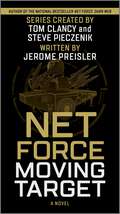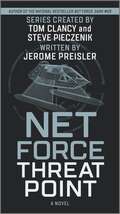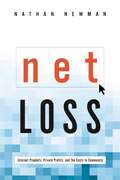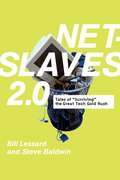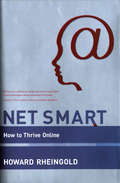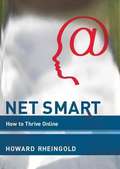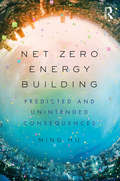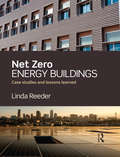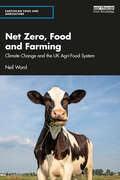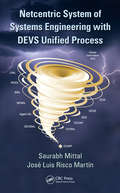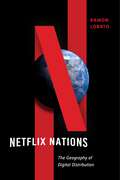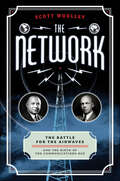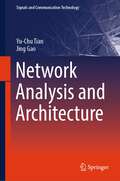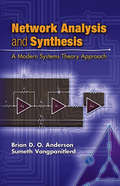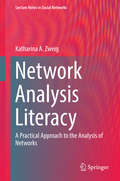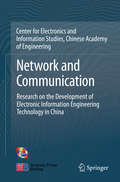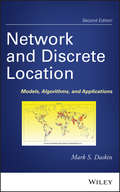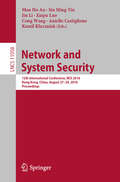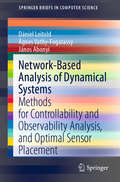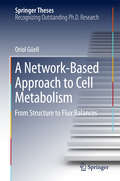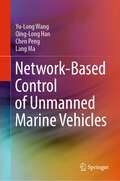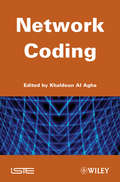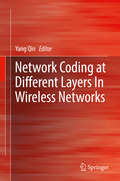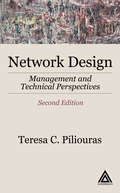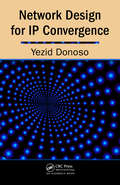- Table View
- List View
Net Force: Moving Target (Net Force Series #4)
by Jerome PreislerA NEW BATTLE IS BREWING—ONE THAT WILL SOON RAGE ACROSS ALL POLITICAL AND GEOGRAPHIC LINES.As this new threat escalates, the US president calls on the members of Net Force to prevent global chaos.In Paris, the leader of a new political movement has gone into hiding, pursued by a relentless group of bioenhanced assassins. Seeking to rescue him in the mysterious catacombs beneath the city is one of Net Force&’s own, Kali Alcazar, who has become a hunted fugitive herself.Halfway across Europe, meanwhile, her friends are about to strike at the heavily armed fortress of the world&’s most dangerous hacker…and he's prepared a deadly trap for them.&“Jerome Preisler takes us deep into the dark side of the web.&” —Jim DeFelice on Net Force: Attack Protocol&“A tightly woven, expertly crafted story with a finger on the pulse of the overwhelmingly clear and present danger of cyberterrorism.&” —Marc Cameron on Net Force: Dark Web
Net Force: Threat Point (Net Force Series #3)
by Jerome PreislerTHE UNITED STATES MAY SEEM SAFE FROM WITHIN BUT BEYOND ITS BORDERS, A NEW ENEMY RISES An American ship has vanished. The president has tasked the new cyber-intelligence agency, Net Force, with finding out what happened to the vessel. But their investigation reveals a plan that could trigger a world war. Their only option is to strike first. Through the streets of New York, a secret city in Crimea and the depths of the South China Sea, Net Force must race to discover who is behind the attack…before it's too late. &“Jerome Preisler takes us deep into the dark side of the web.&” —Jim DeFelice on Net Force: Attack Protocol &“A tightly woven, expertly crafted story with a finger on the pulse of the overwhelmingly clear and present danger of cyberterrorism.&” —Marc Cameron on Net Force: Dark Web
Net Loss: Internet Prophets, Private Profits, and the Costs to Community
by Nathan NewmanHow has the Internet been changing our lives, and how did these changes come about? Nathan Newman seeks the answers to these questions by studying the emergence of the Internet economy in Silicon Valley and the transformation of power relations it has brought about in our new information age. Net Loss is his effort to understand why technological innovation and growth have been accompanied by increasing economic inequality and a sense of political powerlessness among large sectors of the population. Newman first tells the story of the federal government’s crucial role in the early development of the Internet, with the promotion of open computer standards and collaborative business practices that became the driving force of the Silicon Valley model. He then examines the complex dynamic of the process whereby regional economies have been changing as business alliances built around industries like the Internet replace the broader public investments that fueled regional growth in the past. A radical restructuring of once regionally focused industries like banking, electric utilities, and telephone companies is under way, with changes in federal regulation helping to undermine regional planning and the power of local community actors. The rise of global Internet commerce itself contributes to weakening the tax base of local governments, even as these governments increasingly use networked technology to market themselves and their citizens to global business, usually at the expense of all but their most elite residents. More optimistically, Newman sees an emerging countertrend of global use of the Internet by grassroots organizations, such as those in the antiglobalization movements, that may help to transcend this local powerlessness.
Net Slaves 2.0: Tales of Surviving the Great Tech Gold Rush
by Steve Baldwin Bill LessardTechnology professionals, former employees of failed Internet start-ups, downsized corporate workers, and entrepreneurs eager to avoid mistakes of the recent past will be captivated by this humorous and poignant account of the human cost of the dot.com rise and fall. In the sequel to their acclaimed and successful NetSlaves: Tales of Working the Web, the authors profile the people affected by the rise and fall of Internet companies and where they are today. The coverage in this collection of post-dot.com experiences includes the "survivalists", who made it through the storm intact and continue to work in the industry; the "neo-luddites", who have shunned the Internet forever; the "vigilantes", who are screaming for justice for their mistreatment; and many others. By revealing the most absurd moments of "the bubble" and what really happened to the people displaced by the death of the New Economy, this volume is essential reading for anyone who wants to know what these events mean for the future of the Internet industry.
Net Smart: How to Thrive Online (The\mit Press Ser.)
by Howard RheingoldA media guru shows us how to use social media intelligently, humanely, and, above all, mindfully.Like it or not, knowing how to make use of online tools without being overloaded with too much information is an essential ingredient to personal success in the twenty-first century. But how can we use digital media so that they make us empowered participants rather than passive receivers, grounded, well-rounded people rather than multitasking basket cases? In Net Smart, cyberculture expert Howard Rheingold shows us how to use social media intelligently, humanely, and, above all, mindfully. Mindful use of digital media means thinking about what we are doing, cultivating an ongoing inner inquiry into how we want to spend our time. Rheingold outlines five fundamental digital literacies, online skills that will help us do this: attention, participation, collaboration, critical consumption of information (or "crap detection"), and network smarts. He explains how attention works, and how we can use our attention to focus on the tiny relevant portion of the incoming tsunami of information. He describes the quality of participation that empowers the best of the bloggers, netizens, tweeters, and other online community participants; he examines how successful online collaborative enterprises contribute new knowledge to the world in new ways; and he teaches us a lesson on networks and network building. Rheingold points out that there is a bigger social issue at work in digital literacy, one that goes beyond personal empowerment. If we combine our individual efforts wisely, it could produce a more thoughtful society: countless small acts like publishing a Web page or sharing a link could add up to a public good that enriches everybody.
Net Smart: How to Thrive Online
by Howard RheingoldLike it or not, knowing how to make use of online tools without being overloaded with too much information is an essential ingredient to personal success in the twenty-first century. But how can we use digital media so that they make us empowered participants rather than passive receivers, grounded, well-rounded people rather than multitasking basket cases? In Net Smart, cyberculture expert Howard Rheingold shows us how to use social media intelligently, humanely, and, above all, mindfully. Mindful use of digital media means thinking about what we are doing, cultivating an ongoing inner inquiry into how we want to spend our time. Rheingold outlines five fundamental digital literacies, online skills that will help us do this: attention, participation, collaboration, critical consumption of information (or "crap detection"), and network smarts. He explains how attention works, and how we can use our attention to focus on the tiny relevant portion of the incoming tsunami of information. He describes the quality of participation that empowers the best of the bloggers, netizens, tweeters, and other online community participants; he examines how successful online collaborative enterprises contribute new knowledge to the world in new ways; and he teaches us a lesson on networks and network building. Rheingold points out that there is a bigger social issue at work in digital literacy, one that goes beyond personal empowerment. If we combine our individual efforts wisely, it could produce a more thoughtful society: countless small acts like publishing a Web page or sharing a link could add up to a public good that enriches everybody.
Net Zero Energy Building: Predicted and Unintended Consequences
by Ming HuWhat do we mean by net zero energy? Zero operating energy? Zero energy costs? Zero emissions? There is no one answer: approaches to net zero building vary widely across the globe and are influenced by different environmental and cultural contexts. Net Zero Energy Building: Predicted and Unintended Consequences presents a comprehensive overview of variations in 'net zero' building practices. Drawing on examples from countries such as the United States, United Kingdom, Germany, Japan, Hong Kong, and China, Ming Hu examines diverse approaches to net zero and reveals their intended and unintended consequences. Existing approaches often focus on operating energy: how to make buildings more efficient by reducing the energy consumed by climate control, lighting, and appliances. Hu goes beyond this by analyzing overall energy consumption and environmental impact across the entire life cycle of a building—ranging from the manufacture of building materials to transportation, renovation, and demolition. Is net zero building still achievable once we look at these factors? With clear implications for future practice, this is key reading for professionals in building design, architecture, and construction, as well as students on sustainable and green architecture courses.
Net Zero Energy Buildings: Case Studies and Lessons Learned
by Linda ReederThis book presents 18 in-depth case studies of net zero energy buildings—low-energy building that generate as much energy as they consume over the course of a year—for a range of project types, sizes, and U.S. climate zones. Each case study describes the owner’s goals, the design and construction process, design strategies, measurement and verification activities and results, and project costs. With a year or more of post-occupancy performance data and other project information, as well as lessons learned by project owners and developers, architects, engineers, energy modelers, constructors, and operators, each case study answers the questions: What were the challenges to achieving net zero energy performance, and how were these challenges overcome? How would stakeholders address these issues on future projects? Are the occupants satisfied with the building? Do they find it comfortable? Is it easy to operate? How can other projects benefit from the lessons learned on each project? What would the owners, designers, and constructors do differently knowing what they know now? A final chapter aggregates processes to engage in and pitfalls to avoid when approaching the challenges peculiar to designing, constructing, and owning a net zero energy building. By providing a wealth of comparable information, this book which will flatten the learning curve for designing, constructing, and owning this emerging building type and improve the effectiveness of architectural design and construction.
Net Zero, Food and Farming: Climate Change and the UK Agri-Food System (Earthscan Food and Agriculture)
by Neil WardThis book examines the implications of the net zero transition for food and farming in the UK and how these can be managed to avoid catastrophic climate change in the crucial decades ahead. For the UK to meet its international obligations for reducing greenhouse gas emissions, nothing short of a revolution is required in our use of land, our farming practices and our diet. Taking a historical approach, the book examines the evolution of agriculture and the food system in the UK over the last century and discusses the implications of tackling climate change for food, farming and land use, setting the UK situation in an international context. The chapters analyse the key challenges for this transition, including dietary change and food waste, afforestation and energy crops, and low-emission farming practices. This historical perspective helps develop an understanding of how our food, farming and land use system has evolved to be the way that it is, and draws lessons for how the agri-food system could evolve further to support the transition to net zero and avoid catastrophic climate change. Written in a clear and accessible style, this book will be essential reading to students and scholars of food, agriculture and the environment, as well as policymakers and professionals involved climate change policy and the agriculture and food industry.
Netcentric System of Systems Engineering with DEVS Unified Process (System Of Systems Engineering Ser.)
by Saurabh Mittal José L. Risco MartínIn areas such as military, security, aerospace, and disaster management, the need for performance optimization and interoperability among heterogeneous systems is increasingly important. Model-driven engineering, a paradigm in which the model becomes the actual software, offers a promising approach toward systems of systems (SoS) engineering. However, model-driven engineering has largely been unachieved in complex dynamical systems and netcentric SoS, partly because modeling and simulation (M&S) frameworks are stove-piped and not designed for SoS composability. Addressing this gap, Netcentric System of Systems Engineering with DEVS Unified Process presents a methodology for realizing the model-driven engineering vision and netcentric SoS using DEVS Unified Process (DUNIP). The authors draw on their experience with Discrete Event Systems Specification (DEVS) formalism, System Entity Structure (SES) theory, and applying model-driven engineering in the context of a netcentric SoS. They describe formal model-driven engineering methods for netcentric M&S using standards-based approaches to develop and test complex dynamic models with DUNIP. The book is organized into five sections: Section I introduces undergraduate students and novices to the world of DEVS. It covers systems and SoS M&S as well as DEVS formalism, software, modeling language, and DUNIP. It also assesses DUNIP with the requirements of the Department of Defense’s (DoD) Open Unified Technical Framework (OpenUTF) for netcentric Test and Evaluation (T&E). Section II delves into M&S-based systems engineering for graduate students, advanced practitioners, and industry professionals. It provides methodologies to apply M&S principles to SoS design and reviews the development of executable architectures based on a framework such as the Department of Defense Architecture Framework (DoDAF). It also describes an approach for building netcentric knowledge-based contingency-driven systems. Section III guides graduate students, advanced DEVS users, and industry professionals who are interested in building DEVS virtual machines and netcentric SoS. It discusses modeling standardization, the deployment of models and simulators in a netcentric environment, event-driven architectures, and more. Section IV explores real-world case studies that realize many of the concepts defined in the previous chapters. Section V outlines the next steps and looks at how the modeling of netcentric complex adaptive systems can be attempted using DEVS concepts. It touches on the boundaries of DEVS formalism and the future work needed to utilize advanced concepts like weak and strong emergence, self-organization, scale-free systems, run-time modularity, and event interoperability. This groundbreaking work details how DUNIP offers a well-structured, platform-independent methodology for the modeling and simulation of netcentric system of systems.
Netflix Nations: The Geography of Digital Distribution (Critical Cultural Communication #28)
by Ramon LobatoHow streaming services and internet distribution have transformed global television culture.Television, once a broadcast medium, now also travels through our telephone lines, fiber optic cables, and wireless networks. It is delivered to viewers via apps, screens large and small, and media players of all kinds. In this unfamiliar environment, new global giants of television distribution are emerging—including Netflix, the world’s largest subscription video-on-demand service.Combining media industry analysis with cultural theory, Ramon Lobato explores the political and policy tensions at the heart of the digital distribution revolution, tracing their longer history through our evolving understanding of media globalization. Netflix Nations considers the ways that subscription video-on-demand services, but most of all Netflix, have irrevocably changed the circulation of media content. It tells the story of how a global video portal interacts with national audiences, markets, and institutions, and what this means for how we understand global media in the internet age.Netflix Nations addresses a fundamental tension in the digital media landscape – the clash between the internet’s capacity for global distribution and the territorial nature of media trade, taste, and regulation. The book also explores the failures and frictions of video-on-demand as experienced by audiences. The actual experience of using video platforms is full of subtle reminders of market boundaries and exclusions: platforms are geo-blocked for out-of-region users (“this video is not available in your region”); catalogs shrink and expand from country to country; prices appear in different currencies; and subtitles and captions are not available in local languages. These conditions offer rich insight for understanding the actual geographies of digital media distribution. Contrary to popular belief, the story of Netflix is not just an American one. From Argentina to Australia, Netflix’s ascension from a Silicon Valley start-up to an international television service has transformed media consumption on a global scale. Netflix Nations will help readers make sense of a complex, ever-shifting streaming media environment.
The Network: The Battle for the Airwaves and the Birth of the Communications Age
by Scott WoolleyThe astonishing story of America’s airwaves, the two friends—one a media mogul, the other a famous inventor—who made them available to us, and the government which figured out how to put a price on air.This is the origin story of the airwaves—the foundational technology of the communications age—as told through the forty-year friendship of an entrepreneurial industrialist and a brilliant inventor.David Sarnoff, the head of RCA and equal parts Steve Jobs, Jack Welch, and William Randolph Hearst, was the greatest supporter of his friend Edwin Armstrong, developer of the first amplifier, the modern radio transmitter, and FM radio. Sarnoff was convinced that Armstrong’s inventions had the power to change the way societies communicated with each other forever. He would become a visionary captain of the media industry, even predicting the advent of the Internet.In the mid-1930s, however, when Armstrong suspected Sarnoff of orchestrating a cadre of government officials to seize control of the FM airwaves, he committed suicide. Sarnoff had a very different view of who his friend’s enemies were.Many corrupt politicians and corporations saw in Armstrong’s inventions the opportunity to commodify our most ubiquitous natural resource—the air. This early alliance between high tech and business set the precedent for countless legal and industrial battles over broadband and licensing bandwidth, many of which continue to influence policy and debate today.
Network Analysis and Architecture (Signals and Communication Technology)
by Yu-Chu Tian Jing GaoThis book covers network analysis and architecture for large-scale computer network planning. Networks and the Internet are essential for modern industries and societies. Building a new network, upgrading an existing network, or planning to use a public network requires integrating various network mechanisms and technologies in a cohesive fashion. This demands a deep understanding of the concepts, principles, processes, approaches, and good practices of advanced network planning. More specifically, emphasizing service-based networking, the book introduces structured processes for network planning, provides systematic approaches for network analysis and architecture, develops network planning specifications, and discusses high-level network architectural models from various perspectives. It also offers detailed discussions on component-based architecture about addressing, routing, performance, management, and security and privacy. Recent developments in data centers, virtualization, and cloud are also embedded into the network architecture. Moreover, the book includes a comprehensive introduction to building practical TCP/IP network communications via sockets with practical examples. The book is suitable for use as a textbook for senior undergraduate and postgraduate students or as a reference book for network practitioners looking to develop or enhance their skills in network planning.
Network Analysis and Synthesis: A Modern Systems Theory Approach (Dover Books on Engineering)
by Brian D. Anderson Sumeth VongpanitlerdGeared toward upper-level undergraduates and graduate students, this book offers a comprehensive look at linear network analysis and synthesis. It explores state-space synthesis as well as analysis, employing modern systems theory to unite the classical concepts of network theory. The authors stress passive networks but include material on active networks. They avoid topology in dealing with analysis problems and discuss computational techniques. The concepts of controllability, observability, and degree are emphasized in reviewing the state-variable description of linear systems. Explorations of positive real and bounded real functions and matrices include their applications to optimal control, filtering, and stability.Excellent illustrations highlight this text, which represents the definitive tool for integrating an understanding of network theory with related fields such as control theory and communication systems theory.
Network Analysis Literacy
by Katharina A. ZweigThis book presents a perspective of network analysis as a tool to find and quantify significant structures in the interaction patterns between different types of entities. Moreover, network analysis provides the basic means to relate these structures to properties of the entities. It has proven itself to be useful for the analysis of biological and social networks, but also for networks describing complex systems in economy, psychology, geography, and various other fields. Today, network analysis packages in the open-source platform R and other open-source software projects enable scientists from all fields to quickly apply network analytic methods to their data sets. Altogether, these applications offer such a wealth of network analytic methods that it can be overwhelming for someone just entering this field. This book provides a road map through this jungle of network analytic methods, offers advice on how to pick the best method for a given network analytic project, and how to avoid common pitfalls. It introduces the methods which are most often used to analyze complex networks, e. g. , different global network measures, types of random graph models, centrality indices, and networks motifs. In addition to introducing these methods, the central focus is on network analysis literacy - the competence to decide when to use which of these methods for which type of question. Furthermore, the book intends to increase the reader's competence to read original literature on network analysis by providing a glossary and intensive translation of formal notation and mathematical symbols in everyday speech. Different aspects of network analysis literacy - understanding formal definitions, programming tasks, or the analysis of structural measures and their interpretation - are deepened in various exercises with provided solutions. This text is an excellent, if not the best starting point for all scientists who want to harness the power of network analysis for their field of expertise.
Network and Communication: Research on the Development of Electronic Information Engineering Technology in China
by Chinese Academy of EngineeringCurrently, there are global endeavors to integrate network information into the natural world and human society. This process will lead to marked improvements in productivity and product quality, and to new production methods and lifestyles. Further, these advances will have significant impacts, similar to those of the agricultural and industrial revolutions. At the same time, it is profoundly changing competition around the globe. Security, economic, social, military and cultural trends generate new opportunities for national development, new living spaces for humans, new fields of social governance, and new momentum for industrial upgrading and international competition. Over the next 20 years, the development of network communication technologies will focus on three-domain human-network-thing interconnections and their systematic integration into various industries and regions. This will be made possible by digitalization, networking and intellectualization, and will result in the extended connection of human societies around the globe, and a continuously enriched and expanded network space.This book summarizes the development of network communication, both globally and in China, as well as its future prospects from the perspectives of academia, technology and industry. Further, in the context of technology and applications, it focuses on mobile communication, data communication, and optical fiber communication. Discussing application services related to the mobile Internet, Internet of Things, edge computing and quantum communication, it highlights the latest technological advances, future trends, technologies and industry development hotspots. Lastly, it explores 15 buzzwords in the field of network communication in technology and industrial development, providing definitions, and describing the state of development of related applications.
Network and Discrete Location
by Mark S. DaskinPraise for the First EditionThis book is refreshing to read since it takes an important topic... and presents it in a clear and concise manner by using examples that include visual presentations of the problem, solution methods, and results along with an explanation of the mathematical and procedural steps required to model the problem and work through to a solution." --Journal of ClassificationThoroughly updated and revised, Network and Discrete Location: Models, Algorithms, and Applications, Second Edition remains the go-to guide on facility location modeling. The book offers a unique introduction to methodological tools for solving location models and provides insight into when each approach is useful and what information can be obtained.The Second Edition focuses on real-world extensions of the basic models used in locating facilities, including production and distribution systems, location-inventory models, and defender-interdictor problems. A unique taxonomy of location problems and models is also presented. Featuring examples using the author's own software--SITATION, MOD-DIST, and MENU-OKF--as well as Microsoft Office® Excel®, the book provides: * A theoretical and applied perspective on location models and algorithms* An intuitive presentation of the uses and limits of modeling techniques* An introduction to integrated location-inventory modeling and defender-interdictor models for the design of reliable facility location systems* A full range of exercises to equip readers with an understanding of the basic facility location model types Network and Discrete Location: Models, Algorithms, and Applications, Second Edition is an essential resource for practitioners in applied and discrete mathematics, operations research, industrial engineering, and quantitative geography. The book is also a useful textbook for upper-level undergraduate, graduate, and MBA courses.
Network and System Security: 12th International Conference, Nss 2018, Hong Kong, China, August 27-29, 2018, Proceedings (Lecture Notes in Computer Science #11058)
by Man Ho Au Siu Ming Yiu Jin Li Xiapu Luo Cong Wang Aniello Castiglione Kamil KluczniakThis book constitutes the proceedings of the 12th International Conference on Network and System Security, NSS 2018, held in Hong Kong, China, in August 2018. The 26 revised full papers and 9 short papers presented in this book were carefully reviewed and selected from 88 initial submissions. The papers cover a wide range of topics in the field, including blockchain, mobile security, applied cryptography, authentication, biometrics, IoT, privacy, and education.
Network-Based Analysis of Dynamical Systems: Methods for Controllability and Observability Analysis, and Optimal Sensor Placement (SpringerBriefs in Computer Science)
by János Abonyi Ágnes Vathy-Fogarassy Dániel LeitoldThis book explores the key idea that the dynamical properties of complex systems can be determined by effectively calculating specific structural features using network science-based analysis. Furthermore, it argues that certain dynamical behaviours can stem from the existence of specific motifs in the network representation.Over the last decade, network science has become a widely applied methodology for the analysis of dynamical systems. Representing the system as a mathematical graph allows several network-based methods to be applied, and centrality and clustering measures to be calculated in order to characterise and describe the behaviours of dynamical systems. The applicability of the algorithms developed here is presented in the form of well-known benchmark examples. The algorithms are supported by more than 50 figures and more than 170 references; taken together, they provide a good overview of the current state of network science-based analysis of dynamical systems, and suggest further reading material for researchers and students alike. The files for the proposed toolbox can be downloaded from a corresponding website.
A Network-Based Approach to Cell Metabolism
by Oriol GüellThis thesis uses a systems-level approach to study the cellular metabolism, unveiling new mechanisms and responses that were impossible to reach with traditional reductionists procedures. The results reported here have a potential application in areas like metabolic engineering and disease treatment. They could also be used in determining the accuracy of the gene essentiality of new genome-scale reconstructions.Different methods and techniques, within the contexts of Systems Biology and the field known as Complex Networks Analysis have been applied in this work to show different features of the robustness of metabolic networks. The specific issues addressed here range from pure topological aspects of the networks themselves to the balance of biochemical fluxes.
Network-Based Control of Unmanned Marine Vehicles
by Yu-Long Wang Qing-Long Han Chen Peng Lang MaThis book presents a comprehensive analysis of stability, stabilization, and fault detection in networked control systems, with a focus on unmanned marine vehicles. It investigates the challenges of network-based control in areas like heading control, fault detection filter and controller design, dynamic positioning, and cooperative target tracking. Communication networks in control systems can induce delays and dropouts, so the book presents the importance of stability analysis, stabilize, and fault detection. To help readers gain a deeper understanding of these concepts, the book provides fundamental concepts and real-world examples. This book is a valuable resource for researchers and practitioners working in the field of network-based control for unmanned marine vehicles.
Network Coding
by Khaldoun Al AghaNetwork coding, a relatively new area of research, has evolved from the theoretical level to become a tool used to optimize the performance of communication networks – wired, cellular, ad hoc, etc. The idea consists of mixing “packets” of data together when routing them from source to destination. Since network coding increases the network performance, it becomes a tool to enhance the existing protocols and algorithms in a network or for applications such as peer-to-peer and TCP. This book delivers an understanding of network coding and provides a set of studies showing the improvements in security, capacity and performance of fixed and mobile networks. This is increasingly topical as industry is increasingly becoming more reliant upon and applying network coding in multiple applications. Many cases where network coding is used in routing, physical layer, security, flooding, error correction, optimization and relaying are given – all of which are key areas of interest. Network Coding is the ideal resource for university students studying coding, and researchers and practitioners in sectors of all industries where digital communication and its application needs to be correctly understood and implemented. Contents 1. Network Coding: From Theory to Practice, Youghourta Benfattoum, Steven Martin and Khaldoun Al Agha. 2. Fountain Codes and Network Coding for WSNs, Anya Apavatjrut, Claire Goursaud, Katia Jaffrès-Runser and Jean-Marie Gorce. 3. Switched Code for Ad Hoc Networks: Optimizing the Diffusion by Using Network Coding, Nour Kadi and Khaldoun Al Agha. 4. Security by Network Coding, Katia Jaffrès-Runser and Cédric Lauradoux. 5. Security for Network Coding, Marine Minier, Yuanyuan Zhang and Wassim Znaïdi. 6. Random Network Coding and Matroids, Maximilien Gadouleau. 7. Joint Network-Channel Coding for the Semi-Orthogonal MARC: Theoretical Bounds and Practical Design, Atoosa Hatefi, Antoine O. Berthet and Raphael Visoz. 8. Robust Network Coding, Lana Iwaza, Marco Di Renzo and Michel Kieffer. 9. Flow Models and Optimization for Network Coding, Eric Gourdin and Jeremiah Edwards.
Network Coding at Different Layers in Wireless Networks
by Yang QinThis book focuses on how to apply network coding at different layers in wireless networks - including MAC, routing, and TCP - with special focus on cognitive radio networks. It discusses how to select parameters in network coding (e. g. , coding field, number of packets involved, redundant information ration) in order to be suitable for the varying wireless environments. The author explores how to deploy network coding in MAC to improve network performance and examine joint network coding with opportunistic routing to improve the successful rate of routing. In regards to TCP and network coding, the author considers transport layer protocol working with network coding to overcome the transmission error rate, particularly with how to use the ACK feedback of TCP to enhance the efficiency of network coding. The book pertains to researchers and postgraduate students, especially whose interests are in opportunistic routing and TCP in cognitive radio networks.
Network Design: Management and Technical Perspectives
by Teresa C. PiliourasThere are hundreds of technologies and protocols used in telecommunications. They run the full gamut from application level to physical level. It is overwhelming to try to keep track of them. Network Design, Second Edition: Management and Technical Perspectives is a broad survey of the major technologies and networking protocols and how they interr
Network Design for IP Convergence
by Yezid DonosoThe emergence of quality-of-service (QoS) mechanisms continues to propel the development of real-time multimedia services such as VoIP and videoconferencing. However, many challenges remain in achieving optimized standardization convergence. Network Design for IP Convergence is a comprehensive, global guide to recent advances in IP network implementation. Providing an introduction to basic LAN/WAN/MAN network design, the author covers the latest equipment and architecture, addressing, QoS policies, and integration of services, among other topics. The book explains how to integrate the different layers of reference models and various technological platforms to mirror the harmonization that occurs in the real world of carrier networks. It furnishes appropriate designs for traditional and critical services in the LAN and carrier networks (both MAN and WAN), and it clarifies how a specific layer or technology can cause those services to malfunction. This book lays a foundation for understanding with concepts and applicability of QoS parameters under the multilayer scheme, and a solid explanation of service infrastructure. It goes on to describe integration in both real time and "not real time," elaborating on how both processes can co-exist within the same IP network and concluding with the designs and configurations of service connections.Learn How to Overcome Obstacles to Improve TechnologyThis sweeping analysis of the implementation of IP convergence and QoS mechanisms helps designers and operators get past key obstacles, such as integrating platform layers and technologies and implementing various associated QoS concepts, to improve technology and standards.
